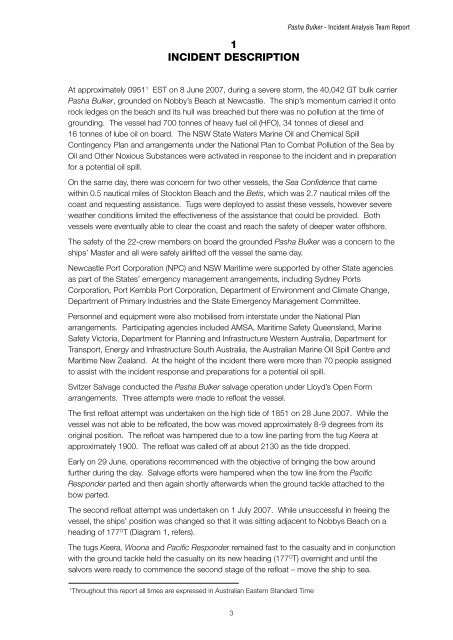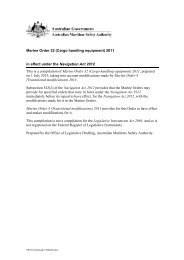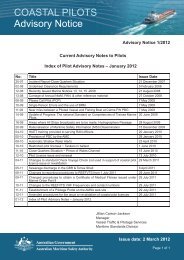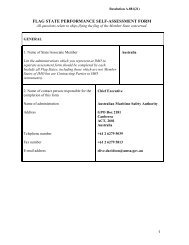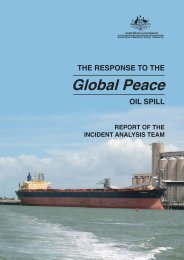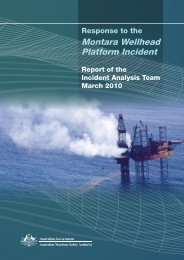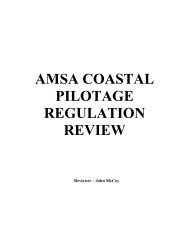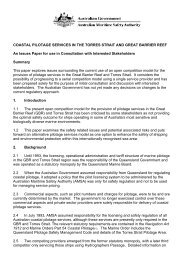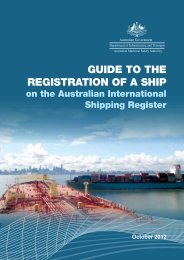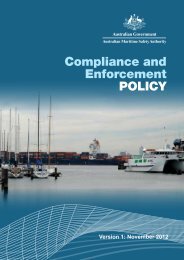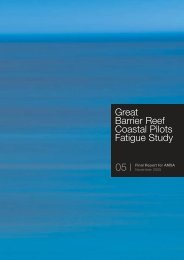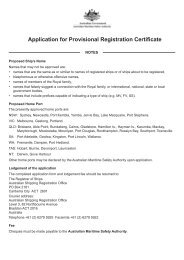Pasha Bulker Report - Australian Maritime Safety Authority
Pasha Bulker Report - Australian Maritime Safety Authority
Pasha Bulker Report - Australian Maritime Safety Authority
You also want an ePaper? Increase the reach of your titles
YUMPU automatically turns print PDFs into web optimized ePapers that Google loves.
1<br />
Incident Description<br />
<strong>Pasha</strong> <strong>Bulker</strong> - Incident Analysis Team <strong>Report</strong><br />
At approximately 0951 1 EST on 8 June 2007, during a severe storm, the 40,042 GT bulk carrier<br />
<strong>Pasha</strong> <strong>Bulker</strong>, grounded on Nobby’s Beach at Newcastle. The ship’s momentum carried it onto<br />
rock ledges on the beach and its hull was breached but there was no pollution at the time of<br />
grounding. The vessel had 700 tonnes of heavy fuel oil (HFO), 34 tonnes of diesel and<br />
16 tonnes of lube oil on board. The NSW State Waters Marine Oil and Chemical Spill<br />
Contingency Plan and arrangements under the National Plan to Combat Pollution of the Sea by<br />
Oil and Other Noxious Substances were activated in response to the incident and in preparation<br />
for a potential oil spill.<br />
On the same day, there was concern for two other vessels, the Sea Confidence that came<br />
within 0.5 nautical miles of Stockton Beach and the Betis, which was 2.7 nautical miles off the<br />
coast and requesting assistance. Tugs were deployed to assist these vessels, however severe<br />
weather conditions limited the effectiveness of the assistance that could be provided. Both<br />
vessels were eventually able to clear the coast and reach the safety of deeper water offshore.<br />
The safety of the 22-crew members on board the grounded <strong>Pasha</strong> <strong>Bulker</strong> was a concern to the<br />
ships’ Master and all were safely airlifted off the vessel the same day.<br />
Newcastle Port Corporation (NPC) and NSW <strong>Maritime</strong> were supported by other State agencies<br />
as part of the States’ emergency management arrangements, including Sydney Ports<br />
Corporation, Port Kembla Port Corporation, Department of Environment and Climate Change,<br />
Department of Primary Industries and the State Emergency Management Committee.<br />
Personnel and equipment were also mobilised from interstate under the National Plan<br />
arrangements. Participating agencies included AMSA, <strong>Maritime</strong> <strong>Safety</strong> Queensland, Marine<br />
<strong>Safety</strong> Victoria, Department for Planning and Infrastructure Western Australia, Department for<br />
Transport, Energy and Infrastructure South Australia, the <strong>Australian</strong> Marine Oil Spill Centre and<br />
<strong>Maritime</strong> New Zealand. At the height of the incident there were more than 70 people assigned<br />
to assist with the incident response and preparations for a potential oil spill.<br />
Svitzer Salvage conducted the <strong>Pasha</strong> <strong>Bulker</strong> salvage operation under Lloyd’s Open Form<br />
arrangements. Three attempts were made to refloat the vessel.<br />
The first refloat attempt was undertaken on the high tide of 1851 on 28 June 2007. While the<br />
vessel was not able to be refloated, the bow was moved approximately 8-9 degrees from its<br />
original position. The refloat was hampered due to a tow line parting from the tug Keera at<br />
approximately 1900. The refloat was called off at about 2130 as the tide dropped.<br />
Early on 29 June, operations recommenced with the objective of bringing the bow around<br />
further during the day. Salvage efforts were hampered when the tow line from the Pacific<br />
Responder parted and then again shortly afterwards when the ground tackle attached to the<br />
bow parted.<br />
The second refloat attempt was undertaken on 1 July 2007. While unsuccessful in freeing the<br />
vessel, the ships’ position was changed so that it was sitting adjacent to Nobbys Beach on a<br />
heading of 177 O T (Diagram 1, refers).<br />
The tugs Keera, Woona and Pacific Responder remained fast to the casualty and in conjunction<br />
with the ground tackle held the casualty on its new heading (177 O T) overnight and until the<br />
salvors were ready to commence the second stage of the refloat – move the ship to sea.<br />
1<br />
Throughout this report all times are expressed in <strong>Australian</strong> Eastern Standard Time<br />
3


